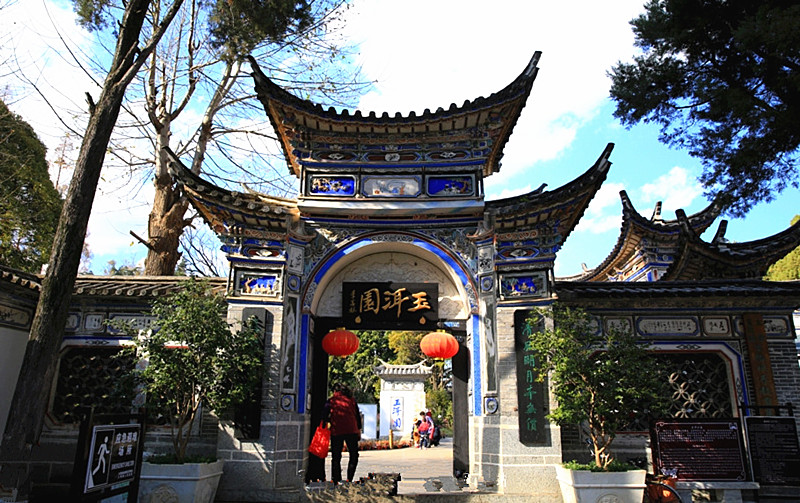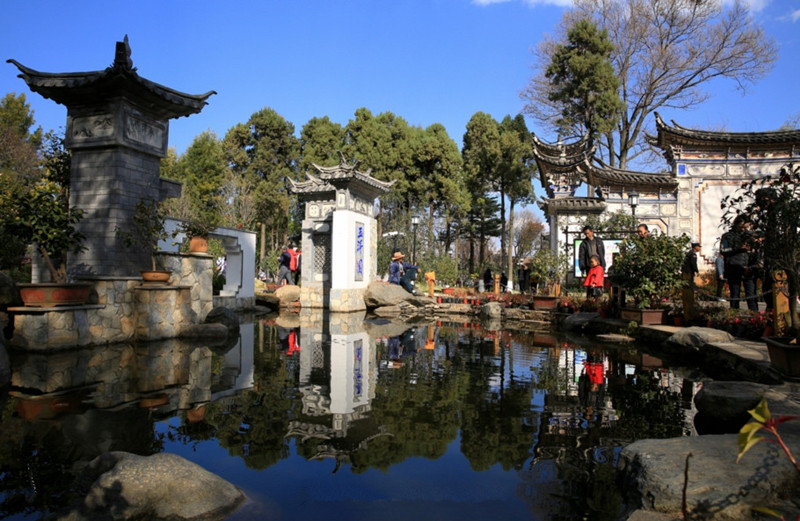Yueryuan Garden in Dali City
Yuer Garden Scenic Area (玉洱园风景区) is located on the north side of the mid-section of Yuer Road (玉洱路) in Dali Ancient Town (大理古城), covering an area of 28 mu. Its original site was the Dali Agricultural and Forestry Experimental Station (大理农林试验场) during the late Qing Dynasty and early Republic of China. During the War of Resistance Against Japan, it was rebuilt as Zhidan Park (志丹公园), and after the liberation, it became a fruit and tree nursery base for the forestry department.
Historically, Dali Ancient Town (大理古城) had several gardens, such as Moyou Garden (默游园), Wu Family Garden (吴家花园), and Yang Family Garden (杨家花园). The tradition of cultivating flowers here was mentioned by Li Yuanyang (李元阳) of the Ming Dynasty in his poem Ode to the Wu Family Garden (《咏吴家花园》).

Architectural Features and Layout
Yuer Garden integrates the architectural characteristics of the Bai ethnic group. Its exterior features include a Bai-style gatehouse with upturned eaves, an elegant and delicate three-sided screen wall, and painted enclosing walls. Inside, the garden centers around Bai-style flower terraces in various shapes, inlaid with stone, and planted with Dali’s famous flowers and exotic plants. There are also facilities such as an elderly activity area, teahouse, memorial pavilion, stone archway, and pond, forming a garden full of the charm of traditional gardens in Dali Ancient Town (大理古城).
Dali is famous for its marble and the ancient practice of large stone worship. Thus, the garden’s decorations are also mainly stone-based, with attractions such as Dashi An (大石庵), Beauty Stone (美人石), Stone Ox (石牛), and Stone Horse Well (石马井). Stone-paved paths, low stone walls, and stone lamp bases emphasize a natural style unique to the garden.

Floral Zones and Cultural Elements
The garden is divided into seven plant zones: camellia, cherry blossom, peony, rhododendron, plum blossom, Chinese rose, and bamboo grove. To enhance its cultural atmosphere, literary figures and calligraphers were invited to inscribe poems, couplets, and paintings, adding refined artistic touches to the garden.

 7 Days GolfingTour
7 Days GolfingTour
 8 Days Group Tour
8 Days Group Tour
 8 Days Yunnan Tour
8 Days Yunnan Tour
 7 Days Shangri La Hiking
7 Days Shangri La Hiking
 11 Days Yunnan Tour
11 Days Yunnan Tour
 6 Days Yuanyang Terraces
6 Days Yuanyang Terraces
 11 Days Yunnan Tour
11 Days Yunnan Tour
 8 Days South Yunnan
8 Days South Yunnan
 7 Days Tea Tour
7 Days Tea Tour
 8 Days Muslim Tour
8 Days Muslim Tour
 12 Days Self-Driving
12 Days Self-Driving
 4 Days Haba Climbing
4 Days Haba Climbing
 Tiger Leaping Gorge
Tiger Leaping Gorge
 Stone Forest
Stone Forest
 Yunnan-Tibet
Yunnan-Tibet
 Hani Rice Terraces
Hani Rice Terraces
 Kunming
Kunming
 Lijiang
Lijiang
 Shangri-la
Shangri-la
 Dali
Dali
 XishuangBanna
XishuangBanna
 Honghe
Honghe
 Kunming
Kunming
 Lijiang
Lijiang
 Shangri-la
Shangri-la
 Yuanyang Rice Terraces
Yuanyang Rice Terraces
 Nujiang
Nujiang
 XishuangBanna
XishuangBanna
 Spring City Golf
Spring City Golf
 Snow Mountain Golf
Snow Mountain Golf
 Stone Mountain Golf
Stone Mountain Golf















